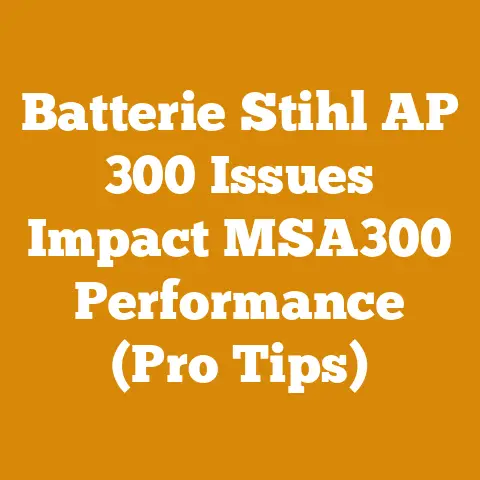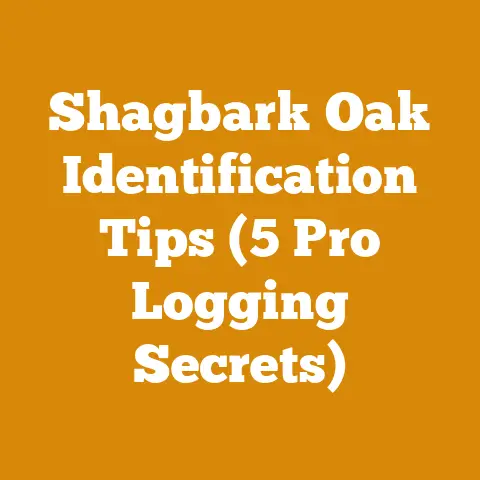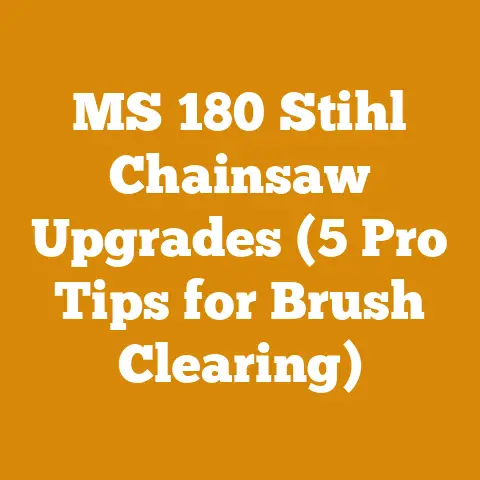Removing Creosote Safely (5 Expert Tips for Chimney Care)
Did you know that creosote buildup in your chimney is a leading cause of house fires? It’s a scary thought, but one I’ve taken seriously ever since I started working with wood stoves and fireplaces. Over the years, I’ve learned that regular chimney maintenance and creosote removal are essential for keeping your home safe and warm. In this guide, I’ll share five expert tips for safely removing creosote and maintaining your chimney. I’ll cover everything from identifying creosote to choosing the right tools and techniques, so you can ensure your chimney is clean and your home is protected.
Removing Creosote Safely: 5 Expert Tips for Chimney Care
Creosote is a byproduct of burning wood in your fireplace or wood stove. It’s a black or brown residue that sticks to the inner walls of your chimney. Over time, creosote can build up and become a fire hazard. As someone who has seen the aftermath of chimney fires, I can’t stress enough how important it is to prevent creosote buildup.
Understanding Creosote: Formation, Risks, and Identification
Creosote forms when the smoke from burning wood cools as it travels up the chimney. This cooling causes the water, gases, and unburned wood particles in the smoke to condense and stick to the chimney walls.
How Creosote Forms
The formation of creosote depends on several factors, including the type of wood you burn, the moisture content of the wood, and the efficiency of your wood-burning appliance. Burning unseasoned wood, for example, produces more smoke and moisture, leading to increased creosote buildup.
The Dangers of Creosote Buildup
The primary danger of creosote buildup is the risk of a chimney fire. Creosote is highly flammable, and even a small spark can ignite it. A chimney fire can quickly spread to the rest of your house, causing significant damage and endangering lives.
I remember one winter when a neighbor’s house caught fire because of a creosote-filled chimney. The fire started small, but it quickly escalated, causing extensive damage. It was a stark reminder of the importance of chimney maintenance.
Identifying Creosote: Three Stages
Creosote comes in three stages, each with its own characteristics and risks:
- Stage 1: This is the initial stage, where creosote appears as a light, flaky soot. It’s relatively easy to remove at this stage.
- Stage 2: As creosote builds up, it becomes a hard, tar-like substance. This stage is more difficult to remove than Stage 1.
- Stage 3: This is the most dangerous stage, where creosote hardens into a shiny, glazed coating. It’s extremely flammable and very difficult to remove.
To check for creosote, you can use a flashlight and mirror to inspect your chimney. Look for black or brown deposits on the inner walls. If you see a significant buildup or if the creosote is hard and glazed, it’s time to take action.
Key Takeaway: Understanding how creosote forms and the risks it poses is the first step in preventing chimney fires. Regular inspections and timely removal are crucial.
Tip 1: Regular Chimney Inspections
Regular chimney inspections are essential for identifying and addressing creosote buildup before it becomes a serious problem. I recommend inspecting your chimney at least twice a year – once before the heating season begins and once after it ends.
Why Inspect Your Chimney Regularly?
Regular inspections allow you to monitor the condition of your chimney and identify any potential issues, such as cracks, blockages, or excessive creosote buildup. By catching these problems early, you can prevent costly repairs and reduce the risk of a chimney fire.
What to Look For During an Inspection
During a chimney inspection, pay attention to the following:
I once had a chimney sweep find a crack in my chimney liner that I had completely missed. It was a small crack, but it could have led to serious problems if left unaddressed.
Key Takeaway: Regular chimney inspections are a proactive way to maintain your chimney and prevent creosote buildup. Don’t hesitate to call a professional for a thorough inspection.
Tip 2: Choose the Right Wood
The type of wood you burn significantly impacts the amount of creosote that forms in your chimney. Burning seasoned hardwood is the best way to minimize creosote buildup.
Seasoned vs. Unseasoned Wood
Seasoned wood has been dried for at least six months, allowing the moisture content to decrease. Unseasoned wood, on the other hand, contains a high amount of moisture. When you burn unseasoned wood, the moisture turns into steam, which cools the smoke and promotes creosote formation.
I learned this lesson the hard way when I first started using a wood stove. I burned some freshly cut wood, and my chimney quickly became coated with creosote. I switched to seasoned wood, and the difference was remarkable.
Best Types of Wood to Burn
Hardwoods like oak, maple, ash, and birch are the best choices for burning in your fireplace or wood stove. These woods burn hotter and cleaner than softwoods, producing less smoke and creosote.
Softwoods like pine and fir contain more sap and resin, which can contribute to creosote buildup. While you can burn softwoods, it’s best to mix them with hardwoods and burn them in small quantities.
How to Season Wood Properly
To season wood properly, you need to split it, stack it, and let it dry for at least six months. Here are some tips for seasoning wood:
- Split the Wood: Splitting the wood increases the surface area, allowing it to dry faster.
- Stack the Wood: Stack the wood in a single row, allowing air to circulate freely.
- Elevate the Wood: Elevate the wood off the ground using pallets or boards to prevent moisture from seeping in.
- Cover the Wood: Cover the top of the woodpile with a tarp to protect it from rain and snow. Leave the sides open to allow for ventilation.
Measuring Moisture Content
You can use a moisture meter to check the moisture content of your wood. The ideal moisture content for firewood is between 15% and 20%. If the moisture content is higher than 20%, the wood needs more time to season.
Key Takeaway: Choosing the right wood is crucial for minimizing creosote buildup. Always burn seasoned hardwood and avoid burning unseasoned wood or softwoods in large quantities.
Tip 3: Burn Hot Fires
Burning hot fires helps to reduce creosote buildup by ensuring that the smoke is hot enough to carry away the unburned particles and gases that contribute to creosote formation.
The Importance of Hot Fires
When you burn a hot fire, the temperature in the chimney stays high, preventing the smoke from cooling and condensing. This reduces the amount of creosote that sticks to the chimney walls.
How to Build a Hot Fire
To build a hot fire, follow these tips:
- Use Kindling: Start with a generous amount of kindling to get the fire going quickly.
- Add Small Pieces of Wood: Add small pieces of wood gradually to build the fire.
- Control Airflow: Adjust the air vents to control the airflow and maintain a hot fire.
- Avoid Smoldering: Avoid letting the fire smolder, as this produces more smoke and creosote.
Monitoring Fire Temperature
You can use a stove thermometer to monitor the temperature of your wood stove or fireplace. The ideal temperature range depends on the type of appliance you have, so consult your owner’s manual for specific recommendations.
The Benefits of a Clean-Burning Fire
In addition to reducing creosote buildup, burning hot fires also improves the efficiency of your wood-burning appliance and reduces air pollution. A clean-burning fire produces less smoke and emits fewer harmful pollutants into the atmosphere.
Key Takeaway: Burning hot fires is an effective way to reduce creosote buildup. Make sure to use kindling, add small pieces of wood gradually, and control the airflow to maintain a hot fire.
Tip 4: Chimney Cleaning Tools and Techniques
Regular chimney cleaning is essential for removing creosote and preventing chimney fires. There are several tools and techniques you can use to clean your chimney, depending on the type of chimney and the amount of creosote buildup.
Essential Chimney Cleaning Tools
Here are some essential tools for cleaning your chimney:
- Chimney Brush: A chimney brush is a long, flexible brush that you use to scrub the inner walls of the chimney. Choose a brush that is the correct size and shape for your chimney.
- Extension Rods: Extension rods are used to extend the reach of the chimney brush. You can connect multiple rods together to clean tall chimneys.
- Weight: A weight can be attached to the chimney brush to help it descend through the chimney.
- Drop Cloth: A drop cloth is used to protect your flooring and furniture from soot and debris.
- Dust Mask and Goggles: A dust mask and goggles are essential for protecting yourself from inhaling soot and dust.
- Shop Vacuum: A shop vacuum is used to clean up the soot and debris after you’ve finished cleaning the chimney.
Chimney Cleaning Techniques
There are two main techniques for cleaning a chimney:
- Top-Down Cleaning: This technique involves cleaning the chimney from the top down, using a chimney brush and extension rods.
- Bottom-Up Cleaning: This technique involves cleaning the chimney from the bottom up, using a chimney brush and extension rods.
I prefer the top-down cleaning method because it allows me to see the progress I’m making and ensures that I’m removing all the creosote.
Step-by-Step Guide to Cleaning Your Chimney
Here’s a step-by-step guide to cleaning your chimney:
- Prepare the Area: Cover your flooring and furniture with a drop cloth to protect them from soot and debris.
- Assemble the Tools: Assemble the chimney brush and extension rods. Attach a weight to the brush if necessary.
- Access the Chimney: Access the chimney from the top or bottom, depending on the technique you’re using.
- Scrub the Chimney: Scrub the inner walls of the chimney with the chimney brush, using a back-and-forth motion.
- Remove the Debris: Remove the soot and debris from the chimney using a shop vacuum.
- Inspect the Chimney: Inspect the chimney for any cracks or damage.
Safety Precautions
When cleaning your chimney, it’s important to take the following safety precautions:
- Wear a Dust Mask and Goggles: Protect yourself from inhaling soot and dust.
- Use a Ladder Safely: If you’re accessing the chimney from the roof, use a sturdy ladder and follow all safety guidelines.
- Work with a Partner: If possible, work with a partner who can assist you and provide support.
- Avoid Windy Days: Avoid cleaning your chimney on windy days, as the soot and debris can be blown into your face and eyes.
Key Takeaway: Regular chimney cleaning is essential for removing creosote and preventing chimney fires. Use the right tools and techniques, and always take safety precautions.
Tip 5: Professional Chimney Sweeping
While you can clean your chimney yourself, it’s important to hire a professional chimney sweep for a thorough inspection and cleaning at least once a year. Professional chimney sweeps have the expertise and equipment to identify and address potential problems that you might miss.
The Benefits of Hiring a Professional
Here are some benefits of hiring a professional chimney sweep:
- Expertise: Professional chimney sweeps have the knowledge and experience to identify and address potential problems with your chimney.
- Equipment: Professional chimney sweeps have specialized equipment for cleaning and inspecting chimneys.
- Safety: Professional chimney sweeps are trained to work safely and efficiently.
- Insurance: Professional chimney sweeps are insured, which protects you in case of accidents or damage.
What to Expect During a Professional Chimney Sweep
During a professional chimney sweep, the chimney sweep will:
- Inspect the Chimney: The chimney sweep will inspect the chimney for any cracks, damage, or blockages.
- Clean the Chimney: The chimney sweep will clean the chimney using specialized tools and techniques.
- Remove the Debris: The chimney sweep will remove the soot and debris from the chimney and dispose of it properly.
- Provide a Report: The chimney sweep will provide you with a report detailing the condition of your chimney and any recommendations for repairs or maintenance.
How to Choose a Chimney Sweep
When choosing a chimney sweep, look for the following:
- Certification: Choose a chimney sweep who is certified by a reputable organization, such as the Chimney Safety Institute of America (CSIA).
- Insurance: Make sure the chimney sweep is insured.
- References: Ask for references from previous customers.
- Experience: Choose a chimney sweep with several years of experience.
I’ve worked with several chimney sweeps over the years, and I’ve always been impressed by their knowledge and professionalism. They’ve helped me keep my chimney in top condition and prevent potential problems.
Key Takeaway: Hiring a professional chimney sweep is a worthwhile investment in the safety and maintenance of your home. Choose a certified and experienced chimney sweep for a thorough inspection and cleaning.
By following these five expert tips, you can safely remove creosote and maintain your chimney, ensuring your home is safe and warm. Remember, regular chimney maintenance is not just about preventing fires; it’s about protecting your family and your property. Take the time to inspect, clean, and maintain your chimney, and you’ll enjoy the warmth and comfort of your fireplace or wood stove for years to come.






